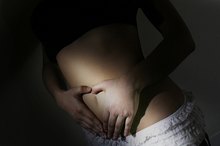How to Wash Your Hands to Kill Sperm
It is possible to impregnate a woman if sperm are on the surface of your hands before digital penetration. Although the chance is infinitesimally small, pregnancy can occur if a single sperm cell is transferred from your hands to a woman's vagina. Killing sperm on your hands is simple, and they die within minutes if you don't do anything at all 4.
These methods help the process along by using basic techniques and chemicals that can be found most households.
Tips
Water, warmth, acid and time can all kill any sperm on a human's hand.
Wash It Off With Water
Sperm thrive in warm, moist areas. Semen can survive in a woman’s vaginal canal up to five days after sex, although usually in a concentration small enough that there is little risk of pregnancy. Generally speaking, two days after unprotected sex, the concentration of sperm is low enough that pregnancy is unlikely.
That said, you don't have to wait days. Wash your hands. Enough tap water can kill sperm found outside a human body through osmotic shock, the process by which a sudden change in the water surrounding a cell causes a rapid movement of water across its membrane, which compromises the membrane.
- Sperm thrive in warm, moist areas.
- Semen can survive in a woman’s vaginal canal up to five days after sex, although usually in a concentration small enough that there is little risk of pregnancy.
Chemical Warfare
What Causes Ejaculation?
Learn More
Acid can also kill sperm cells. A human vagina usually has a pH between 4.0 and 4.5, although it becomes less acidic during times of fertility. This pH is, by itself, more than enough to kill sperm. However, semen contains a chemically basic barrier that protects a man’s genetic data. That said, lemon juice – common in many households –is more acid at a pH of 2. Researchers have shown that half a teaspoon of lemon juice can kill 2 teaspoons of sperm in 30 seconds.
Aside from that, household soaps and detergents can also kill sperm by chemically stripping away their cell membranes.
- Acid can also kill sperm cells.
- Aside from that, household soaps and detergents can also kill sperm by chemically stripping away their cell membranes.
Leave Them Out to Dry
A sperm’s life cycle begins when it is ejaculated from a man’s body. Following that, it actively seeks out an egg to fertilize. The average human male ejaculates around 200 million sperm each time he climaxes. The sperm are designed to survive in a woman’s vagina and are ill-suited to open air and dry surfaces. When all the moisture in semen is gone, all the sperm within it are dead. Outside the body, this process can be as short as a couple of minutes and last up to 20 minutes, depending on atmospheric factors and the volume of semen ejaculated. It’s not necessarily the most time-effective method, but it is available nonetheless.
Increasing airflow and applying heat to your hands can help this process along. Both air circulation and heat increase the rate of evaporation, and temperatures above 98.6 degrees Fahrenheit also contribute to sperm decomposition.
- A sperm’s life cycle begins when it is ejaculated from a man’s body.
Related Articles
References
- Oakland University: Mechanisms of Sperm Mobility
- New Scientist: Lemon Juice Is "HIV-Killing Spermicide"
- Fertility and Sterility: The Effect of Temperature on Sperm Mobility and Viability
- Sperm.com: How Does Sperm Die?
- Live Science: Why Are 250 Million Sperm Cells Released During Sex?
- Machen GL, Harris SE, Bird ET, et al. Utilization of cryopreserved sperm cells based on the indication for storage. Investig Clin Urol. 2018;59(3):177-81. doi:10.4111/icu.2018.59.3.177
- Di Santo M, Tarozzi N, Nadalini M, Borini A. Human sperm cryopreservation: update on techniques, effect on DNA integrity, and implications for ART. Adv Urol. 2012;2012:854837. doi:10.1155/2012/854837
Writer Bio
Doug Johnson is an Edmonton-based writer, editor and journalist.








